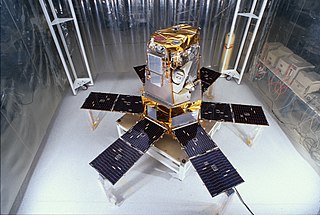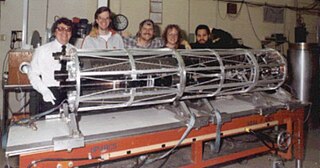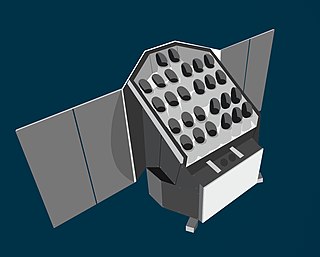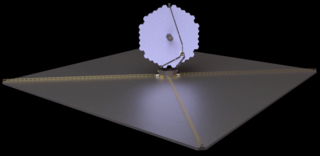
The Laboratory for Atmospheric and Space Physics (LASP) is a research organization at the University of Colorado Boulder. LASP is a research institute with over one hundred research scientists ranging in fields from solar influences, to Earth's and other planetary atmospherics processes, space weather, space plasma and dusty plasma physics. LASP has advanced technical capabilities specializing in designing, building, and operating spacecraft and spacecraft instruments.
The Extreme ultraviolet Imaging Telescope (EIT) is an instrument on the SOHO spacecraft used to obtain high-resolution images of the solar corona in the ultraviolet range. The EIT instrument is sensitive to light of four different wavelengths: 17.1, 19.5, 28.4, and 30.4 nm, corresponding to light produced by highly ionized iron (XI)/(X), (XII), (XV), and helium (II), respectively. EIT is built as a single telescope with a quadrant structure to the entrance mirrors: each quadrant reflects a different colour of EUV light, and the wavelength to be observed is selected by a shutter that blocks light from all but the desired quadrant of the main telescope.

The Solar Radiation and Climate Experiment (SORCE) was a NASA-sponsored satellite mission that measured incoming X-ray, ultraviolet, visible, near-infrared, and total solar radiation. These measurements specifically addressed long-term climate change, natural variability, atmospheric ozone, and UV-B radiation, enhancing climate prediction. These measurements are critical to studies of the Sun, its effect on the Earth's system, and its influence on humankind. SORCE was launched on 25 January 2003 on a Pegasus XL launch vehicle to provide NASA's Earth Science Enterprise (ESE) with precise measurements of solar radiation.

The Multi-spectral solar telescope array, or MSSTA, was a sounding rocket payload built by Professor A.B.C. Walker, Jr. at Stanford University in the 1990s to test EUV/XUV imaging of the Sun using normal incidence EUV-reflective multilayer optics. MSSTA contained a large number of individual telescopes, all trained on the Sun and all sensitive to slightly different wavelengths of ultraviolet light. Like all sounding rockets, MSSTA flew for approximately 14 minutes per mission, about 5 minutes of which were in space—just enough time to test a new technology or yield "first results" science. MSSTA is one of the last solar observing instruments to use photographic film rather than a digital camera system such as a CCD. MSSTA used film instead of a CCD in order to achieve the highest possible spatial resolution and to avoid the electronics difficulty presented by the large number of detectors that would have been required for its many telescopes.

The Cosmic Origins Spectrograph (COS) is a science instrument that was installed on the Hubble Space Telescope during Servicing Mission 4 (STS-125) in May 2009. It is designed for ultraviolet (90–320 nm) spectroscopy of faint point sources with a resolving power of ≈1,550–24,000. Science goals include the study of the origins of large scale structure in the universe, the formation and evolution of galaxies, and the origin of stellar and planetary systems and the cold interstellar medium. COS was developed and built by the Center for Astrophysics and Space Astronomy (CASA-ARL) at the University of Colorado at Boulder and the Ball Aerospace and Technologies Corporation in Boulder, Colorado.

The Extreme Ultraviolet Explorer was a NASA space telescope for ultraviolet astronomy. EUVE was a part of NASA's Explorer spacecraft series. Launched on 7 June 1992. With instruments for ultraviolet (UV) radiation between wavelengths of 7 and 76 nm, the EUVE was the first satellite mission especially for the short-wave ultraviolet range. The satellite compiled an all-sky survey of 801 astronomical targets before being decommissioned on 31 January 2001.

An ocean world, ocean planet, panthalassic planet, maritime world, water world or aquaplanet, is a type of planet that contains a substantial amount of water in the form of oceans, as part of its hydrosphere, either beneath the surface, as subsurface oceans, or on the surface, potentially submerging all dry land. The term ocean world is also used sometimes for astronomical bodies with an ocean composed of a different fluid or thalassogen, such as lava, ammonia or hydrocarbons. The study of extraterrestrial oceans is referred to as planetary oceanography.

PLAnetary Transits and Oscillations of stars (PLATO) is a space telescope under development by the European Space Agency for launch in 2026. The mission goals are to search for planetary transits across up to one million stars, and to discover and characterize rocky extrasolar planets around yellow dwarf stars, subgiant stars, and red dwarf stars. The emphasis of the mission is on Earth-like planets in the habitable zone around Sun-like stars where water can exist in a liquid state. It is the third medium-class mission in ESA's Cosmic Vision programme and is named after the influential Greek philosopher Plato. A secondary objective of the mission is to study stellar oscillations or seismic activity in stars to measure stellar masses and evolution and enable the precise characterization of the planet host star, including its age.
The NASA Star and Exoplanet Database (NStED) is an on-line astronomical stellar and exoplanet catalog and data service that collates and cross-correlates astronomical data and information on exoplanets and their host stars. NStED is dedicated to collecting and serving important public data sets involved in the search for and characterization of exoplanets and their host stars. The data include stellar parameters, exoplanet parameters and discovery/characterization data.
The Carl Sagan Institute: Pale Blue Dot and Beyond was founded in 2014 at Cornell University in Ithaca, New York to further the search for habitable planets and moons in and outside the Solar System. It is focused on the characterization of exoplanets and the instruments to search for signs of life in the universe. The founder and current director of the institute is astronomer Lisa Kaltenegger.

A superhabitable planet is a hypothetical type of exoplanet or exomoon that may be better suited than Earth for the emergence and evolution of life. The concept was introduced in 2014 by René Heller and John Armstrong, who have criticized the language used in the search for habitable planets and proposed clarifications. According to Heller and Armstrong, knowing whether or not a planet is in its host star's habitable zone (HZ) is insufficient to determine its habitability: It is not clear why Earth should offer the most suitable physicochemical parameters to living organisms, as "planets could be non-Earth-like, yet offer more suitable conditions for the emergence and evolution of life than Earth did or does." While still assuming that life requires water, they hypothesize that Earth may not represent the optimal planetary habitability conditions for maximum biodiversity; in other words, they define a superhabitable world as a terrestrial planet or moon that could support more diverse flora and fauna than there are on Earth, as it would empirically show that its environment is more hospitable to life.

The Large Ultraviolet Optical Infrared Surveyor, commonly known as LUVOIR, is a multi-wavelength space telescope concept being developed by NASA under the leadership of a Science and Technology Definition Team. It is one of four large astrophysics space mission concepts studied in preparation for the National Academy of Sciences 2020 Astronomy and Astrophysics Decadal Survey.

The Habitable Exoplanet Observatory (HabEx) is a space telescope concept that would be optimized to search for and image Earth-size habitable exoplanets in the habitable zones of their stars, where liquid water can exist. HabEx would aim to understand how common terrestrial worlds beyond the Solar System may be and determine the range of their characteristics. It would be an optical, UV and infrared telescope that would also use spectrographs to study planetary atmospheres and eclipse starlight with either an internal coronagraph or an external starshade.

Origins Space Telescope (Origins) is a concept study for a far-infrared survey space telescope mission. A preliminary concept in pre-formulation, it was presented to the United States Decadal Survey in 2019 for a possible selection to NASA's large strategic science missions. Origins would provide an array of new tools for studying star formation and the energetics and physical state of the interstellar medium within the Milky Way using infrared radiation and new spectroscopic capabilities.

Ross 128 b is a confirmed Earth-sized exoplanet, likely rocky, that is orbiting within the inner habitable zone of the red dwarf Ross 128, at a distance of around 11 light-years from Earth. The exoplanet was found using a decade's worth of radial velocity data using the European Southern Observatory's HARPS spectrograph at the La Silla Observatory in Chile. Ross 128 b is the nearest exoplanet around a quiet red dwarf, and is considered one of the best candidates for habitability. The planet is only 35% more massive than Earth, receives only 38% more starlight, and is expected to be a temperature suitable for liquid water to exist on the surface, if it has an atmosphere.

SISTINE is a NASA mission designed to study distant stars as a way of finding life on exoplanets.
TOI-700 is a red dwarf 101.4 light-years away from Earth located in the Dorado constellation that hosts TOI-700 d, the first Earth-sized exoplanet in the habitable zone discovered by Transiting Exoplanet Survey Satellite (TESS).
Large Interferometer For Exoplanets (LIFE) is a project started in 2017 to develop the science, technology and a roadmap for a space mission to detect and characterize the atmospheres of dozens of warm, terrestrial extrasolar planets. The current plan is for a nulling interferometer operating in the mid-infrared.

Habitability of yellow dwarf systems defines the suitability for life of exoplanets belonging to yellow dwarf stars. These systems are the object of study among the scientific community because they are considered the most suitable for harboring living organisms, together with those belonging to K-type stars.

















